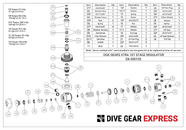SaltyWombat
Contributor
The DGX Gears XTRA first stage caught my attention since I like balanced piston regs.
- It appears to have two high pressure o-rings, both marked 26* in the attached schematic. In the disassembly video, the o-ring closest to the ambient chamber seems challenging to remove. Is it actually not a big deal?
- The DIN assembly appears more complicated than others I'm accustomed to, say Atomic and Scubapro. For example, the Filter Retainer part D10 in the schematic seems like it could be combined with the Retainer Housing part D8. The Filter Retainer looks a bit like a yoke retainer even though this is a DIN reg. Any thoughts if this added complexity was required to accommodate the optional ACD auto-closure feature?





